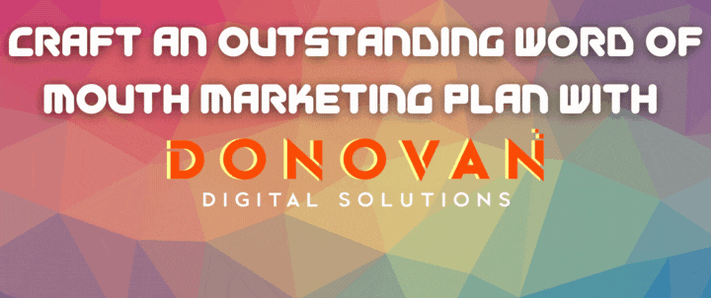"Does Word-of-Mouth Advertising Still Apply to My Market?"
It’s a fair question to ask in today’s world of high-tech marketing. After all, with so many options for reaching our target markets, why would we bother with something as old-fashioned as word-of-mouth?
The Crucial Importance of Word of Mouth Marketing
Here’s the thing: even in this age of digital marketing, word-of-mouth is still one of the most powerful tools at our disposal. In fact, it may be more important than ever.
Think about it this way: in a world where we’re bombarded with marketing messages 24/7, it’s harder than ever to cut through the noise and reach our target market. That’s where word-of-mouth comes in.
When someone we know and trust recommends a product or service, we’re much more likely to take notice. It’s a form of social proof that can be incredibly powerful.
Of course, there’s no guarantee that word-of-mouth will always work in your favor. But, if you can generate even a small amount of buzz around your business, it can make a big impact.
Word-of-Mouth Marketing: What Is It, Exactly?
The classic definition of word-of-mouth marketing is “the act of voluntarily passing along a favorable message about a product, service, or company.” In other words, it’s when someone tells their friends or family about how much they love your product or service — and those people then go and buy it for themselves.
It’s the most powerful form of marketing because it comes from a trusted source (i.e., a friend, family member, or someone with similar interests).
The Origins and Development of Word-of-Mouth Advertising
Word-of-mouth advertising has been around since the beginning of time. It is the oldest and most effective form of marketing. In its simplest form, word-of-mouth advertising is when one person tells another person about a product or service they like.
The power of word-of-mouth advertising lies in its ability to build trust and credibility. When someone we know and trust recommends a product or service, we are more likely to try it ourselves.
While this technique has long been part of doing business, George Silverman, a psychologist, noticed and studied the concept in the 1970s. He created “teleconferenced peer influence groups,” which targeted physicians to try new pharmaceutical products. Silverman noticed that the participants changed their opinion about a product after hearing a positive endorsement from their peers.
In the years since, word-of-mouth advertising has evolved and become more sophisticated. Businesses have developed ways to identify and track customers who are likely to generate word-of-mouth buzz for their products or services. They have also found ways to encourage and amplify word-of-mouth marketing by going digital and using social media, customer referral programs, and other techniques.
How To Properly Utilize Word of Mouth Marketing
These are the ways to properly utilize word-of-mouth marketing:
Create a Product or Service Worth Bragging About
The first thing you need to do is create a product or service that’s actually worth talking about. If you have an unremarkable product, word of mouth advertising is not going to work for you. You need to be able to offer consumers something they can get excited about so they’ll be more likely to tell their friends and family about your business.
In this digital age, a high-quality product or service that goes the extra mile is something people will gladly talk about on their social media platforms. You also need to make sure your product is accessible and easy to purchase. No one is going to bother recommending a product that’s difficult to find or purchase.
Maximize Visual Triggers
Instagrammable cafes and restaurants have become extremely popular in recent years. A big reason for this is that people love taking pictures of their food and posting them online. When potential customers see photos of their friends eating at beautiful establishments, it triggers their own desire to visit the place and have a similar experience.
As a business owner, you can take advantage of this by making sure your establishment is visually appealing and provides a great experience that will encourage customers to take photos and post about it online.
Boost User-Generated Content
User-generated content (UGC) is one of the most powerful tools you have at your disposal when it comes to word-of-mouth marketing. UGC can take many forms, from user reviews and testimonials to social media posts and even photos or videos.
One of the best ways to encourage UGC is to make it easy for your customers and fans to share their experiences with your brand. This could mean adding social sharing buttons to your website or blog, running social media contests, or simply asking customers to leave reviews on popular review sites.
Creating an Effective Word-of-Mouth Marketing Plan
Follow these steps to create an effective word-of-mouth marketing plan for your business:
1. Identify Your Unique Value Proposition
What is it about your product or service that makes it special? Why would customers want to recommend it to their friends? You need to determine this before you can begin to craft a word-of-mouth marketing strategy since it will be the foundation of all your marketing efforts.
Your value proposition doesn’t need to be overly complicated. In fact, it’s often best to keep it simple so that it’s easy for customers to remember and share with others.
Once you’ve identified your unique value proposition, make sure it’s prominently featured on your website and all your marketing materials. This will help to ensure that everyone who comes in contact with your brand knows what makes you different and why they should recommend you to their friends.
2. Optimize Your Website
Next, you must optimize your website to make it as shareable as possible. Include social media sharing buttons on each page of your site, and make sure that the content is high quality and interesting enough that people will want to share it. You should also include a call-to-action on each page, encouraging visitors to take a specific action, such as signing up for your email list or following you on social media.
This way, even if someone doesn’t purchase anything from you, they can still help spread the word about your business.
3. Nurture Your Relationship With Current Customers
Take care of your current customers. They are the ones who’ve experienced your product or service first-hand and are in the best position to tell others about you. If they’re happy with what you’ve provided, they’ll be more likely to recommend you to their friends and family.
You can also encourage them to leave reviews on your website or social media pages, which can help attract new customers. When you engage with your customers and show that you care about their experience, they’ll be more likely to tell others about you.
4. Incentivize Feedback
A great way to encourage word-of-mouth marketing is by incentivizing customers to leave reviews or feedback about their experience with your product or service. This can be done in a number of ways, such as offering discounts or coupons for those who leave reviews or simply by asking customers to spread the word to their friends and family.
When you offer rewards for feedback, make sure that the process is easy and straightforward. The last thing you want is for customers to get frustrated trying to leave a review and give up altogether.
Incentivizing feedback is a great way to get customers talking about your business, and it can help you generate valuable insights about what people like or don’t like about your product or service.
5. Share Testimonials and Reviews
Once you receive a testimonial or review, post it to your website, blog, and social media channels. If you have a brick-and-mortar business, be sure to display them prominently in your store. This way, when potential customers see that others have had a positive experience with your product or service, they’ll be more likely to give your products and services a try.
How Does Word-of-Mouth Marketing Fit With the Digital Age?
Word-of-mouth marketing still remains one of the most powerful forms of marketing, even in the digital age. In fact, it could be argued that word-of-mouth is more important than ever before given the amount of competition for attention online.
Moreover, customers can now more easily share their experiences with a wider audience via social media and review sites. Opinions now carry more weight and can have a greater impact on potential customers.
Technology has also made it easier for companies to track the effectiveness of their word-of-mouth marketing campaigns and to identify influencers within specific target markets. So, if you’re not already incorporating word-of-mouth marketing into your overall marketing strategy, now is the time to start.
How Can Donovan Digital Solutions Help?
Donovan Digital Solutions helps businesses grow by driving word-of-mouth advertising through digital channels. Our team of experts will help you identify and track your most valuable customers and turn them into promoters by providing an exceptional experience every time they interact with your brand.
Our team of experts have years of experience in word-of-mouth marketing and can help you craft a strategy that will work for your business. We offer a full suite of services, including social media monitoring, online reputation management, and customer loyalty programs.
Schedule a free enterprise consultation now to learn more about how we can help you grow your business with word-of-mouth marketing.
FAQs Word-of-Mouth Marketing
1. Is word of mouth a reliable source?
Many consider word of mouth to be the most reliable source when it comes to making a buying decision. In fact, 92% of consumers say they trust recommendations from friends and family more than any other form of advertising.
2. What is the most effective word-of-mouth marketing strategy?
There’s no definitive answer to this question as it depends on the product or service being marketed and the target audience. However, some general tips include identifying social media influencers who could help promote your brand and creating content that is shareable and interesting.
3. How does word-of-mouth affect consumers?
Consumers view recommendations from friends, family, and other people they trust as more credible than advertising because of the source’s perceived lack of bias. In other words, consumers believe that people they know will not steer them wrong.
References:
https://www.extole.com/blog/a-to-z-wom-part-1-a-brief-history-of-word-of-mouth-marketing/
https://www.investopedia.com/terms/w/word-of-mouth-marketing.asp
https://blog.hubspot.com/agency/how-online-word-of-mouth-marketing-is-changing
https://www.bigcommerce.com/articles/ecommerce/word-of-mouth-marketing/








